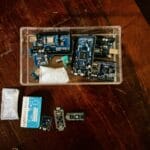FPGA Insights has engaged in an exclusive interview with Shreyas Mhetar, FPGA Engineer at Bit Mapper Integration Technologies Pvt. Ltd – A Phoenix Group Company
Q1) Can you provide an overview of your experience with FPGA design projects mentioning a few that you’ve worked on, starting with a brief introduction?
I had done my 6 months of internship and around a year of working experience in FPGA specifically in the Video processing and ISP field. FPGA camera is nothing but a camera sensor with FPGA for processing video streaming. I have experience in handling FPGAs like 7 series FPGAs i.e. Spartan 7 and Artix 7. Currently, I am working on Zynq 7000 Soc. Worked with communication protocols like IIC, SPI, and UART with Camera sensors.
Right now I am working on customizing IP made by HLS (High-Level Synthesis) for various video applications like mixing streams, cropping the resolution, and image fusion.
I used and studied various IP and their vital coding for specific and general applications like Video MIXER, MIPI CSI, Video processing subsystem VPSS, and many more.
Q2) Can you explain the benefits of using FPGAs over other types of processors?
FPGA has more numbers of advantages over other processors as I am mentioning below:-
1) Support parallel processing – FPGA can data with different protocols in a parallel manner which helps to reduce time.
2) Customization – We can customize FPGA as per our application needs.
3) Performance – FPGA can provide higher performance than CPU and GPU
4) Flexibility – we can reprogram the FPGA whenever we want without any big hardware changes.
Q3) What are the most significant trends observed in the FPGA industry over the past year? How will these trends shape the industry’s future?
As we know FPGA industry is now the most focused field in India and there are many trends observed in FPGA that will give shape to the industry.
1) AI and machine learning – as I am working on an FPGA camera we can include AI and ML for better improvement in product
2) FPGA cameras – In the new era of FPGA, FPGA-based cameras are the main aspects because of parallel processing and speed.
Q4) How do you see FPGA development evolving to meet the demands of modern applications and complex workloads?
There are several key trends and advancements which shaping the future of FPGA development:
1) Modern application like AI and ML requires more computational power and flexibility which can be provided by FPGA.
2) Advancement is done in FPGA to overcome barriers to entry and speed up development. The advancement is like HLS and vision libraries.
3) Enhancement of performance and power.
4) Scalability and flexibility
Q5) Key drivers behind the increasing adoption of FPGAs in various applications and industries?
Key drivers behind the Adoption of FPGA in various applications and industries are;
1) Customization and flexibility- Customization makes FPGA most favorable in industries because we can customize the FPGA as per our needs and application point of view. We can develop our hardware and our software for specific applications.
2) Parallel processing- FPGA provides parallel processing, it can process large volumes of data in parallel.
3) Energy efficient – FPGA is more energy efficient compared to traditional processors.FPGA has several techniques for energy utilization like edge computing and data centers.
4) Scalability.
5) Supports for emerging technology – FPGA can be used in both AI and ML models and offers both performance and adaptability to evolving algorithms.
Q6) Sectors that stand to benefit the most from FPGA integration, and why?
1) Telecommunication –
FPGA is beneficial in the following manner-
Low latency and high throughput.
Adaptability.
Real-time processing.
2) Automotive industry
FPGA provides real-time data processing essential for safety critical systems that require immediate responses to sensor inputs.
3) Defense – FPGA offers high reliability and performance necessary for mission-critical applications. Enable the development of various custom solutions for radar, communication, and electronic warfare systems.
4) Robotics –
precision and control.
Real-time processing.
durability
Q7) The role of FPGAs in accelerating AI applications and advancements expected in the near future.
FPGAs play a crucial role in accelerating AI applications due to their ability to provide the following things
1) Customizable acceleration – FPGA can be configured to create specific applications and processing pipelines for AI tasks.
2) Parallel processing – They support massive parallelism, which is essential for parallel computation required in AI.
3) Real-time processing – FPGAs offer low latency processing making them ideal for real-time AI inference tasks in applications.
Expected advancements in FPGA
1) FPGA vendors are increasingly providing robust support for popular AI frameworks.
2) High-level synthesis(HLS) – Tool that allows the design of FPGA logic using high-level programming languages.
Q8) Ensuring the security and integrity of FPGA designs, especially in sensitive applications like finance and defense.
Here are several strategies and best practices to enhance the security and integrity of FPGA designs:
1) Bitfile – bitstream encryption prevents unauthorized access and tampering.
2) Authentication for bitstream to ensure that only verified bitstream is loaded
3) Design security- it consists of IP protection cores through encryption and licensing mechanisms.
4) Runtime security – under this section, two techniques come into view secure communication and access control
Q9) Advice for students and professionals interested in pursuing a career in FPGA development to stay updated with the latest trends and technologies.
Some advice on how to keep up with the fast-evolving field of FPGA development:
1) Take some specialization courses or certification in FPGA development.
2) Hands-on projects.
3) Internship.
4) Online tutorial.
5) Books.
6) Social media.
7) Webinar and workshop.
8) Formal education.












